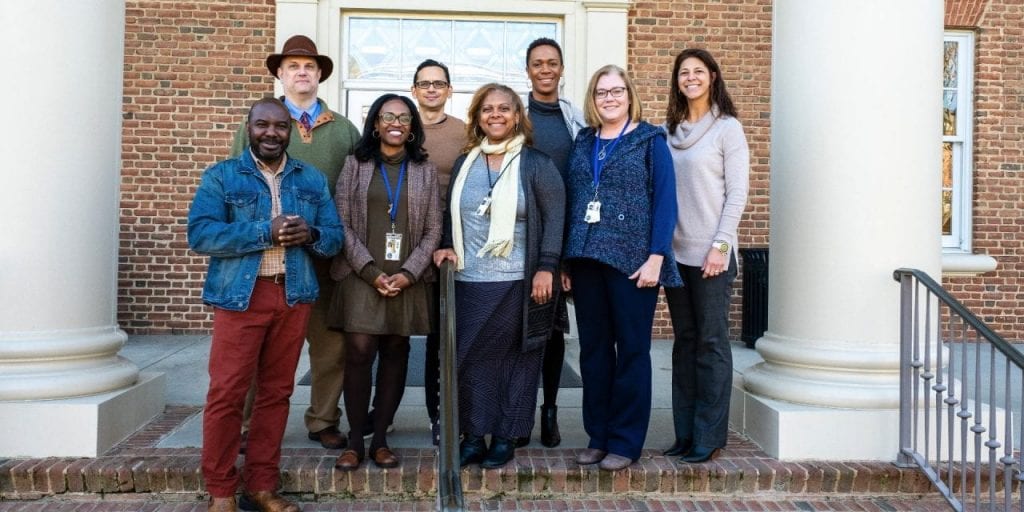Front row, left-to-right: Shelton Shepherd, Twanna Monds, Donna Eason, Kelly Wiebe, Freya Kridle. Back row: Bill Velto, German Urioste, Danielle Johnson-Webb (not pictured: Trish Yu)
Imagine over seven thousand independent-school educators, from across America and around the world, the vast majority of them people of color—Latinos, African Americans, Native Americans, Asians—congregated in one place to seek pedagogical, psychological, and spiritual inspiration from dynamic speakers, eye-opening workshops, and engaging affinity groups. What does that all add up to? Hands down the best conference I’ve ever been to—and I’ve been to my fair share in my twenty-five years as a teacher.
I’ve had the pleasure and the privilege of attending the People of Color Conference twice, most recently in December. With a cohort of other CA educators, I traveled to Seattle for three days of professional and personal enrichment. Suffice it to say, we all experienced just that. How could we not? The conference’s theme—1619. 2019. Before. Beyond. Amplifying Our Intelligence to Liberate, Co-create, and Thrive—commemorated the 400 years since the first slave ships reached the so-called “New World”, and the keynote speaker, Dr. Joy DeGruy, an internationally renowned expert on “the intersection of racism, trauma, violence, and American chattel slavery”, as noted in the program, brought the house down with her rousing presentation on how the enduring legacies of horrific past injustices can be overcome by education, resilience, and community. Amid darkness, there is hope—that’s what she conveyed to her rivetted audience.
Or how about Valarie Kaur? A modern-day Renaissance woman—civil rights activist, celebrated documentary filmmaker, lawyer, and founder of the Revolutionary Love Project—she spoke eloquently about love as a form of “sweet labor”, imploring us to see ourselves in the suffering of others, not only in those most unlike us but also in those who espouse hatred. There are no monsters, she insisted, only wounded humans. What’s beneath their stories? What’s behind their hate? Forgiveness, Ms. Kaur declared, is not forgetting; it’s freedom from hate.
I could go on about the speakers. Want to learn about what it’s like to grow up in Los Angeles as a gay Filipino American? Look no further than Dr. Anthony Ocampo, who told his own story to convey the struggles and the triumphs gay men of color from immigrant families experience coming of age in America. As faculty sponsor for the GSA and the son of Bolivian immigrants, I found Dr. Ocampo’s talk especially fascinating.
How about the workshops? Perhaps the most intriguing one I attended was titled “They Don’t See Me Either: Fighting the Bias of Artificial Intelligence”, about how AI systems that use facial recognition, retinal scanning, and other biometrics too often feature built-in gender and racial biases, a consequence of flawed data sets created by programmers often unaware of their own inherent and often unconscious prejudices.
Finally, the affinity groups. At CA, as well as at the two other independent schools I’ve taught at, I’ve always been a minority, one of a handful of Latino faculty, so you can imagine how inspiring it was to be in an overflowing conference room with scores of other Latino independent school educators from around the country. In small groups, we shared our stories—who we are, where we come from, why we teach—stories as varied and vital as our familial, cultural, and geographical backgrounds.
I’m lucky to teach at a school that values professional development, and I can’t thank CA enough for affording me this transformative experience. As an English Department, we collaborate to enrich our literary selections with interdisciplinary connections—film clips and essays, short stories and poems, historical studies and current events—and the insights I’ve gained from the People of Color Conference will undoubtedly inform my thinking as I work with my colleagues to refine existing courses and create new ones.

